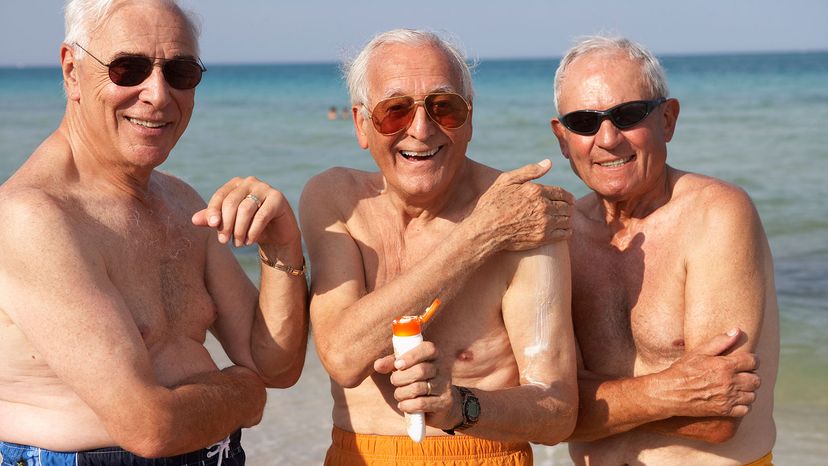 “A new study found that people applied far less sunscreen to their bodies than they should for effectiveness. Rolf Brudere/Getty Images
“A new study found that people applied far less sunscreen to their bodies than they should for effectiveness. Rolf Brudere/Getty Images
It’s August, which in America means long, lazy days at the beach, pool or amusement park — hours of outdoor fun under the blazing summer sun. Most of us are smart enough to use a sunscreen with SPF 30 or higher when sun exposure is extra intense, but a new study finds that we’re not applying it as thickly as we should, cutting sunscreen’s effectiveness by 40 percent.
Sunscreen is rated for its sun protection factor (SPF), with SPF 30 able to block 97 percent of UV rays. The higher the SPF, the greater the protection, although even SPF 100 doesn’t block 100 percent of UV light.
The problem, according to new research out of University College London, is that few of us use enough sunscreen to enjoy those high levels of protection. Lead author Antony Young explains via email that to calculate SPF ratings in the lab, sunscreen is applied at a thickness of 2 milligrams of product per each square centimeter of skin.
"An average woman has about 1.7 square meters (18.3 square feet) of skin," writes Young. "For a whole-body sunscreen, she will need about 33 grams (1.1 fluid ounces). With three whole body applications a day, that’s about 100 grams (3.4 fluid ounces)."
For reference, 1 fluid ounce is roughly equivalent to a shot glass full of sunscreen and a large tube of sunscreen holds just 8 fluid ounces of product. So, one person spending a full day in the sun should use nearly half a tube all by herself.
Are you using that much sunscreen? Probably not. And you may not like the feel of it either.
Young and his colleagues estimate that our "real-life" application of sunscreen is closer to 0.75 milligrams per square centimeter, less than 40 percent of the recommended thickness. As a result, we’re not getting anything close to the 97-percent protection promised on a bottle of SPF 30.
The good news from Young’s study is that you can get away with using less product with SPFs of 50 or higher. He found even the real-world application rate of 7.5 milligrams of SPF 50 sunscreen per square centimeter provided "considerable DNA protection" compared to untreated skin.
Real-world Sunscreen Strategies
Does that mean you should run out and buy the most expensive SPF 100 or spread your regular SPF 30 as thick as cream cheese on a raisin bagel?
You could, says Ivy Lee, a board-certified dermatologist based in Pasadena, California, but the best daily sun protection strategy is to keep it realistic.
"I tell my patients to go for the highest SPF possible that feels good on the skin for daily use," says Lee. "How do you know you’re really applying 2 milligrams per square centimeter? No one knows. We don’t want to induce anxiety over this; we want to build healthy habits."
Skin cancer is the most common type of cancer in the United States and exposure to ultraviolet (UV) light is a risk factor for all types of cancer, including melanoma. More than 9,300 Americans will die from melanoma in 2018, according to the American Academy of Dermatology (AAD).
Unprotected exposure to UV light damages the DNA in skin cells, leaving them more susceptible to skin cancer. DNA damage can result from either a few severe sunburns or a lifetime of cumulative sun exposure. Incredibly, the AAD reports that getting just five or more blistering sunburns between ages 15 and 20 will increase your overall melanoma risk by 80 percent.
Healthy sun protection habits include avoiding sun exposure during the peak hours between 10 a.m. to 2 p.m., wearing a wide-brimmed hat and sunglasses when outside in full sun, and of course, applying sunscreen on all exposed skin, even in overcast conditions.
For full coverage, Lee recommends starting the day with a cream or lotion-type sunscreen, preferably 15 to 30 minutes before you step outside. Instead of measuring out a full shot glass of product, Lee tells her clients to think of applying sunscreen like a massage — working it fully into the skin without missing a spot. Since body sizes vary, and products spread differently, there’s no preset amount that works for everyone.
Lee suggests reserving spray or powder-type sunscreens for fast reapplication on the go. The ideal is to reapply every two hours, but Lee says a more realistic plan is to reapply around lunchtime. If you’re heading out on water, sand or snow, more frequent applications are required since UV rays reflect off those surfaces.
And what about people with naturally dark skin? Do they need to use the same amount of sunscreen. Lee says that although skin cancer is less prevalent in people of color, exposure to UV light can also cause premature aging. Daily sunscreen use will slow the appearance of wrinkles and age spots for all skin tones.
Now That’s Interesting
According to Lee, it’s a myth that you can’t burn the palms of your hands or soles of your feet. Also, tablets and other handheld devices reflect UV light, too, so pick a shady spot to scroll.

